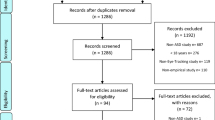Abstract
Purpose of Review
Children with autism spectrum (ASD) demonstrate atypical visual processing. This review investigated the current literature from 2018 to 2022 on the visual processing regarding visual attention, gaze behaviors, and stimuli preferences of children with ASD via eye tracking studies.
Recent Findings
Children with ASD demonstrated less visual attention in terms of time to first visit, fixation duration, and time per visit towards social stimuli when they are compared with TD children. Both TD children and ASD children showed greater preference for circumscribed objects than non-circumscribed ones. Female ASD children showed better visual attention to social stimuli like faces than male ASD children. Atypical performance of joint attention was also found.
Summary
This review indicated the visual processing of children with ASD compared with TD. Future research focusing on changes in visual processing and eye gaze performance across developmental lifespan stages of ASD individuals was suggested.

Similar content being viewed by others
References
Papers of particular interest, published recently, have been highlighted as: • Of importance •• Of major importance
American Psychiatric Association. Diagnostic and statistical manual of mental disorders: DSM-IV-TR. Washington, DC: American Psychiatric Association; 2010.
American Psychiatric Association. Diagnostic and statistical manual of mental disorders. 5th ed. Arlington, VA: American Psychiatric Association; 2013.
Amos D, Hass S, Markant J. An eye tracking investigation of developmental change in bottom-up attention orienting to faces in cluttered natural scenes. PLoS ONE. 2014;9(1):E85701. https://doi.org/10.1371/journal.pone.0085701.
Blaswer E, Eglington L, Carter AS, Kaldy Z. Pupillometry reveals a mechanism for the autism spectrum disorder (ASD) advantage in visual tasks. Sci Rep. 2014;4(1):1–5. https://doi.org/10.1038/srep04301.
Beuker KT, Rommelse NN, Donders R, Buitelaar JK. Development of early communication skills in the first two years of life. Infant Behav Dev. 2013;36(1):71–83. https://doi.org/10.1016/j.infbeh.2012.11.001.
Boraston Z, Blakemore SJ. The application of eye-tracking technology in the study of autism. Physiol J. 2007;581(3):893–8. https://doi.org/10.1113/jphysiol.2007.133587.
• Cai X, Le J, Shou X, Wu-Yun G, Wang X, Han S, et al. The salience of competing nonsocial objects reduces gaze toward social stimuli, but not the eyes, more in typically developing than autistic boys. Autism Res. 2022;15(6):1043–55. https://doi.org/10.1113/jphysiol.2007.133587. (This study finds differences in visual fixation on social and non-social stimuli across the TD and ASD groups.)
Calder AJ, Lawrence AD, Keane J, Scott SK, Owen AM, Christoffels I, et al. Reading the mind from eye gaze. Neuropsychologia. 2002;40(8):1129–38. https://doi.org/10.1016/S0028-3932(02)00008-8.
Chan MM, Han YM. Differential mirror neuron system (MNS) activation during action observation with and without social-emotional components in autism: a meta-analysis of neuroimaging studies. Mol Autism. 2020;11(1):1–18. https://doi.org/10.1186/s13229-020-00374-x.
• Corbetta M, Shulman GL. Control of goal-directed and stimulus-driven attention in the brain. Nat Rev Neurosci. 2002;3(3):201–15. https://doi.org/10.1038/nrn755. (This explains the difference in nature of DAN and VAN.)
Corbetta M, Shulman GL. The reorienting system of the human brain: from environment to theory of mind. Neuron. 2008;58(3):306–24. https://doi.org/10.1016/j.neuron.2008.04.017.
Corden B, Chilvers R, Skuse D. Avoidance of emotionally arousing stimuli predicts social–perceptual impairment in Asperger’s syndrome. Neuropsychologia. 2008;46(1):137–47. https://doi.org/10.1016/j.neuropsychologia.2007.08.005.
Dalton KM, Nacewicz BM, Johnstone T, Schaefer HS, Gernsbacher MA, Goldsmith HH, et al. Gaze fixation and the neural circuitry of face processing in autism. Nat Neurosci. 2005;8(4):519–26. https://doi.org/10.1038/nn1421.
Dawson G, Meltzoff AN, Osterling J, Rinaldi J, Brown E. Children with autism fail to orient to naturally occurring social stimuli. J Autism Dev Disord. 1998;28(6):479–85. https://doi.org/10.1023/A:1026043926488.
Dean M, Harwood R, Kasari C. The art of camouflage: gender differences in the social behaviors of girls and boys with autism spectrum disorder. Autism. 2017;21(6):678–89. https://doi.org/10.1177/1362361316671845.
• Farrant K, Uddin LQ. Atypical developmental of dorsal and ventral attention networks in autism. Dev Sci. 2016;19(4):550–63. https://doi.org/10.1111/desc.12359. (This explains the DAN and VAN atypical reactivity in individuals with ASD.)
Fichtenholtz HM, Dean HL, Dillon DG, Yamasaki H, McCarthy G, LaBar KS. Emotion–attention network interactions during a visual oddball task. Cogn Brain Res. 2004;20(1):67–80. https://doi.org/10.1016/j.cogbrainres.2004.01.006.
Freeth M, Foulsham T, Chapman P. The influence of visual saliency on fixation patterns in individuals with autism spectrum disorders. Neuropsychologia. 2011;49(1):156–60. https://doi.org/10.1016/j.neuropsychologia.2010.11.012.
• Harrop C, Jones D, Zheng S, Nowell SW, Boyd BA, Sasson N. Sex differences in social attention in autism spectrum disorder. Autism Res. 2018;11(9):1264–75. https://doi.org/10.1002/aur.1997. (This study finds sex difference in visual attention of ASD individuals.)
• Harrop C, Jones D, Sasson N, Zheng S, Nowell S, Parish-Morris J. Social and object attention is influenced by biological sex and toy gender-congruence in children with and without autism. Autism Res. 2020;13(5):763–76. https://doi.org/10.1002/aur.2245. (This study finds differences in response to joint attention in ASD individuals.)
Ishizaki Y, Higuchi T, Yanagimoto Y, Kobayashi H, Noritake A, Nakamura K, et al. Eye gaze differences in school scenes between preschool children and adolescents with high-functioning autism spectrum disorder and those with typical development. Biopsychosoc Med. 2021;15(1):2–7. https://doi.org/10.1186/s13030-020-00203-w.
Inuggi A, Sassi F, Castillo A, Campoy G, Leocani L, García Santos JM, et al. Cortical response of the ventral attention network to unattended angry facial expressions: an EEG source analysis study. Front Psychol. 2014;5:1498. https://doi.org/10.3389/fpsyg.2014.01498.
Kliemann D, Dziobek I, Hatri A, Steimke R, Heekeren HR. Atypical reflexive gaze patterns on emotional faces in autism spectrum disorders. J Neurosci. 2010;30(37):12281–7. https://doi.org/10.1523/JNEUROSCI.0688-10.2010.
Kothari R, Skuse D, Wakefield J, Micali N. Gender differences in the relationship between social communication and emotion recognition. J Am Acad Child Adolesc Psychiatry. 2013;52(11):1148–57. https://doi.org/10.1111/1475-6811.00033.
Liss M, Saulnier C, Fein D, Kinsbourne M. Sensory and attention abnormalities in autistic spectrum disorders. Autism. 2006;10(2):155–72. https://doi.org/10.1177/1362361306062021.
Lord C, Luyster RJ, Gotham K, Guthrie W. Autism diagnostic observation schedule. 2nd ed. (ADOS-2) manual (Part II): toddler module. Torrance: Western Psychological Services; 2012.
Loth E, Gómez JC, Happé F. Event schemas in autism spectrum disorders: the role of theory of mind and weak central coherence. J Autism Dev Disord. 2008;38(3):449–63. https://doi.org/10.1007/s10803-007-0412-2.
• Mo S, Liang L, Bardikoff N, Sabbagh M. Shifting visual attention to social and non-social stimuli in autism spectrum disorders. Res Autism Spectr Disord. 2019;65:56–64. https://doi.org/10.1016/j.rasd.2019.05.006. (This study finds differences in saccadic reaction time to CI, non-CI, and social stimuli across ASD and TD children.)
Mundy P, Jarrold W. Infant joint attention, neural networks and social cognition. Neural Netw. 2010;23(8):985–97. https://doi.org/10.1016/j.neunet.2010.08.009.
• Muratori F, Billeci L, Calderoni S, Boncoddo M, Lattarulo C, Costanzo V, et al. How attention to faces and objects changes over time in toddlers with autism spectrum disorders: preliminary evidence from an eye tracking study. Brain Sci. 2019;9(12):334. https://doi.org/10.3390/brainsci9120344. (This study finds differences in initiating joint attention in ASD.)
Nobre AC, Sebestyen GN, Gitelman DR, Mesulam MM, Frackowiak RS, Frith CD. Functional localization of the system for visuospatial attention using positron emission tomography. Brain. 1997;120(3):515–33. https://doi.org/10.1093/brain/120.3.515.
Nomi J, Uddin L. Face processing in autism spectrum disorders: from brain regions to brain networks. Neuropsychologia. 2015;71:201–16. https://doi.org/10.1016/j.neuropsychologia.2015.03.029.
Pantelis PC, Kennedy DP. Deconstructing atypical eye gaze perception in autism spectrum disorder. Sci Rep. 2017;7(1):1–10. https://doi.org/10.1038/s41598-017-14919-3.
Pierce K, Conant D, Hazin R, Stoner R, Desmond J. Preference for geometric patterns early in life as a risk factor for autism. Arch Gen Psychiatry. 2011;68(1):101–9. https://doi.org/10.1001/archgenpsychiatry.2010.113.
Sasson NJ, Elison JT, Turner-Brown LM, Dichter GS, Bodfish JW. Brief report: circumscribed attention in young children with autism. J Autism Dev Disord. 2011;41(2):242–7. https://doi.org/10.1007/s10803-010-1038-3.
Sasson NJ, Touchstone EW. Visual attention to competing social and object images by preschool children with autism spectrum disorder. J Autism Dev Disord. 2014;44(3):584–92. https://doi.org/10.1007/s10803-013-1910-z.
Senju A, Johnson MH. Atypical eye contact in autism: models, mechanisms and development. Neurosci Biobehav Rev. 2009;33(8):1204–14. https://doi.org/10.1016/j.neubiorev.2009.06.001.
Tang WY, Fong KN, Chung RC. The effects of storytelling with or without social contextual information regarding eye gaze and visual attention in children with autistic spectrum disorder and typical development: a randomized, controlled eye-tracking study. J Autism Dev Disord. 2021;52(3):1257–67. https://doi.org/10.1007/s10803-021-05012-w.
Tottenham N, Hertzig ME, Gillespie-Lynch K, Gilhooly T, Millner AJ, Casey BJ. Elevated amygdala response to faces and gaze aversion in autism spectrum disorder. Soc Cogn Affect Neurosci. 2014;9(1):106–17. https://doi.org/10.1093/scan/nst050.
•• Vacas J, Antolí A, Sánchez-Raya A, Pérez-Dueñas C, Cuadrado F. Visual preference for social vs. non-social images in young children with autism spectrum disorders. An eye tracking study. PloS One. 2021;16(6):e0252795. https://doi.org/10.1371/journal.pone.0252795. (This recent study finds differences in social attention and object attention by measuring total fixation duration, time per visit, and time to first fixation across the ASD and TD groups.)
Wang S, Xu J, Jiang M, Zhao Q, Hurlemann R, Adolphs R. Autism spectrum disorder, but not amygdala lesions, impairs social attention in visual search. Neuropsychologia. 2014;63:259–74. https://doi.org/10.1016/j.neuropsychologia.2014.09.002.
• Wang Q, Hoi SP, Wang Y, Lam CM, Fang F, Yi L. Gaze response to others’ gaze following in children with and without autism. J Abnorm Psychol. 2020;129(3):320–9. https://doi.org/10.1037/abn0000498. (This study finds differences in response to joint attention in ASD individuals.)
Wen TH, Cheng A, Andreason C, Zahiri J, Xiao Y, Xu R, et al. Large scale validation of an early-age eye-tracking biomarker of an autism spectrum disorder subtype. Sci Rep. 2022;12(1):1–13. https://doi.org/10.1038/s41598-022-08102-6.
Author information
Authors and Affiliations
Corresponding author
Ethics declarations
Conflict of Interest
The author declares no competing interests.
Human and Animal Rights and Informed Consent
This article does not contain any studies with human or animal subjects performed by any of the authors.
Additional information
Publisher's Note
Springer Nature remains neutral with regard to jurisdictional claims in published maps and institutional affiliations.
This article is part of the Topical Collection on Sensory Modulation
Rights and permissions
Springer Nature or its licensor holds exclusive rights to this article under a publishing agreement with the author(s) or other rightsholder(s); author self-archiving of the accepted manuscript version of this article is solely governed by the terms of such publishing agreement and applicable law.
About this article
Cite this article
Tang, W.Y.F. Application of Eye Tracker to Detect Visual Processing of Children with Autism Spectrum Disorder. Curr Dev Disord Rep 9, 77–88 (2022). https://doi.org/10.1007/s40474-022-00252-6
Accepted:
Published:
Issue Date:
DOI: https://doi.org/10.1007/s40474-022-00252-6




